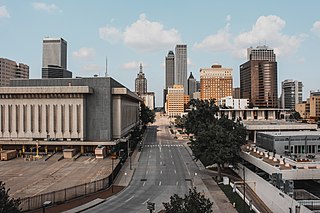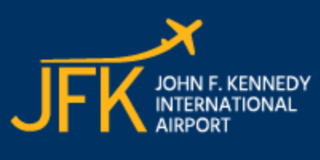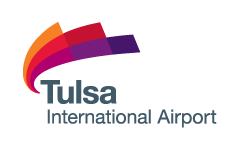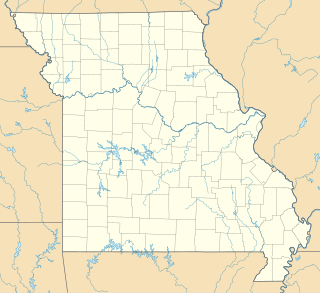



The Kansas City Overhaul Base is a 1,700,000-square-foot (160,000 m2) manufacturing and maintenance plant adjacent to Kansas City International Airport.

Kansas City International Airport is a public airport 15 miles (24 km) northwest of downtown Kansas City in Platte County, Missouri. In 2018, 11,850,825 passengers used the airport, the second busiest in its history. Its largest carriers are Southwest Airlines and Delta Air Lines, both having many daily flights in Terminal B. The airport has always been a civilian airport and has never had an Air National Guard unit assigned to it. The number of peak-day scheduled aircraft departures for December 2018 was 170. Service was offered to 47 nonstop markets.
The plant at its peak in the 1960s and 1970s employed more than 6,000 people who worked on repairing the entire fleet of Trans World Airlines (and other airlines under contract) and it was Kansas City's biggest employer. Since TWA's successor American Airlines began downsizing in preparation for a total abandonment effective September 2010, three companies moved their headquarters and plants into the complex (Smith Electric Vehicles (US), Jet Midwest and Nordic Windpower). Frontier Airlines leased two narrow-body hangars.

Trans World Airlines (TWA) was a major American airline that existed from 1930 until 2001. It was formed as Transcontinental & Western Air to operate a route from New York City to Los Angeles via St. Louis, Kansas City, and other stops, with Ford Trimotors. With American, United, and Eastern, it was one of the "Big Four" domestic airlines in the United States formed by the Spoils Conference of 1930.
American Airlines, Inc. (AA) is a major American airline headquartered in Fort Worth, Texas, within the Dallas-Fort Worth metroplex. It is the world's largest airline when measured by fleet size, revenue, scheduled passengers carried, scheduled passenger-kilometers flown, and number of destinations served. American, together with its regional partners, operates an extensive international and domestic network with an average of nearly 6,700 flights per day to nearly 350 destinations in more than 50 countries. American Airlines is a founding member of Oneworld alliance, the third largest airline alliance in the world. Regional service is operated by independent and subsidiary carriers under the brand name American Eagle.

Smith Electric Vehicles was a manufacturer of electric trucks. The company, founded in 1920 in the north of England, moved its headquarters to Kansas City, Missouri in 2011. In 2015, Smith idled its manufacturing and it ceased all operations in 2017.
The plant along with the airport opened in 1957 at a cost of $25 million and was marked an attempt to keep TWA in Kansas City following the Great Flood of 1951 which had destroyed TWA's facilities at Fairfax Airport close to the Missouri River. TWA's plant had been in the former North American Aviation B-25 Mitchell bomber plant at Fairfax. TWA labeled the building MCIE (after the airport's original name of Mid-Continent International Airport). [1] The airline also moved its large overhaul operations at the New Castle County Airport in Delaware to Kansas City. [2]

In mid-July 1951, heavy rains led to a great rise of water in the Kansas River and other surrounding areas of the central United States. Flooding resulted in the Kansas, Neosho, Marais Des Cygnes, and Verdigris river basins. The damage in June and July 1951 exceeded $935 million in an area covering eastern Kansas and Missouri, which, adjusting for inflation, is nearly $8.52 billion in 2016. The flood resulted in the loss of 17 lives and displaced 518,000 people.

The Missouri River is the longest river in North America. Rising in the Rocky Mountains of western Montana, the Missouri flows east and south for 2,341 miles (3,767 km) before entering the Mississippi River north of St. Louis, Missouri. The river takes drainage from a sparsely populated, semi-arid watershed of more than half a million square miles (1,300,000 km2), which includes parts of ten U.S. states and two Canadian provinces. When combined with the lower Mississippi River, it forms the world's fourth longest river system.

North American Aviation (NAA) was a major American aerospace manufacturer, responsible for a number of historic aircraft, including the T-6 Texan trainer, the P-51 Mustang fighter, the B-25 Mitchell bomber, the F-86 Sabre jet fighter, the X-15 rocket plane, and the XB-70, as well as Apollo command and service module, the second stage of the Saturn V rocket, the Space Shuttle orbiter and the B-1 Lancer.
In 1973, when the airport opened to replace Kansas City Downtown Airport as the city's main airport, TWA also added its distinctive sloped wide-body hangars. [1]
When American Airlines acquired financially bankrupt TWA in 2001, TWA had 2,600 employees at the base. [3]
In 2008, American moved about 500 of its remaining 1,000 employees to Tulsa, Oklahoma and American formally cut the ties in September 2010. Barack Obama visited the Smith Electric part of the plant to tout the $32 million in stimulus funding granted to Smith to locate to the structure.

Tulsa is the second-largest city in the state of Oklahoma and 45th-most populous city in the United States. As of July 2016, the population was 413,505, an increase of 12,591 over that reported in the 2010 Census. It is the principal municipality of the Tulsa Metropolitan Area, a region with 991,005 residents in the MSA and 1,251,172 in the CSA. The city serves as the county seat of Tulsa County, the most densely populated county in Oklahoma, with urban development extending into Osage, Rogers, and Wagoner counties.

Barack Hussein Obama II is an American attorney and politician who served as the 44th president of the United States from 2009 to 2017. A member of the Democratic Party, he was the first African American to be elected to the presidency. He previously served as a U.S. senator from Illinois from 2005 to 2008.
The Economic Stimulus Act of 2008 was an Act of Congress providing for several kinds of economic stimuli intended to boost the United States economy in 2008 and to avert a recession, or ameliorate economic conditions. The stimulus package was passed by the U.S. House of Representatives on January 29, 2008, and in a slightly different version by the U.S. Senate on February 7, 2008. The Senate version was then approved in the House the same day. It was signed into law on February 13, 2008 by President Bush with the support of both Democratic and Republican lawmakers. The law provides for tax rebates to low- and middle-income U.S. taxpayers, tax incentives to stimulate business investment, and an increase in the limits imposed on mortgages eligible for purchase by government-sponsored enterprises. The total cost of this bill was projected at $152 billion for 2008.
Kansas City says that 1 million feet have been leased.
In 2009, Kansas City broke ground on the KCI Intermodal Center, Kansas City SmartPort foreign trade zone on 800 acres across Runway 9/27 directly south of the plant being developed by Trammell Crow Company. [4]












